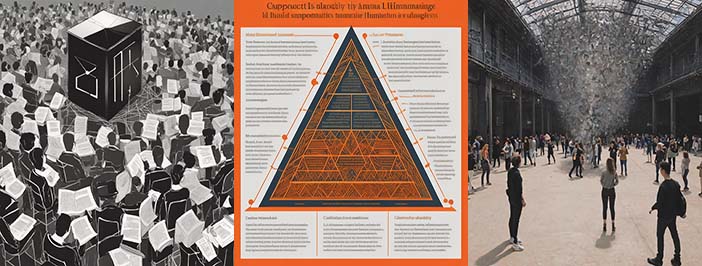
Teaching Knowledge Labor and Literacy for the Age of AI and Beyond with Rhetorical Information Theory
Patrick Love Monmouth University
Introduction
Crypto currency and blockchain architecture, having suffered major public downturns, receded in late 2022 as if making way for mainstream generative artificial intelligence (GenAI) products, replacing decentralized ledgers in public imagination with automatically generated pictures and text via OpenAI’s DALL-E and ChatGPT. An emblematic response was Stephen Marche’s December 2022 article declaring ChatGPT and its underpinning product, GPT-3, the death of the “college essay,” heralding yet another crisis in the humanities, and questioning the value of writing and the humanities in education. Rhetoric and Composition scholars will note the tropes in Marche’s prose implying that writing primarily serves transactional purposes, particularly in academia. Marche’s declaration that the “undergraduate essay” is how “we teach (students) to research, think, and write” is easy enough to get behind, but the point is muddied by a subsequent claim: an unnamed Toronto Associate Professor (presumably of Business) claims that, when writing assignments ask “specific questions that involve combining knowledge across domains,” ChatGPT “is frankly better than the average MBA at this point” (Marche, 2022). Marche’s implied concern is that AI writing can now recreate Knowledge, provided Knowledge is a compelling summary, comparison, or analysis of other writing.
One might understand pedagogical writing and humanities disciplines (like Marche implies) as existing to produce compelling understandings of the present via evidence from the past, placing the future outside its domain (like ChatGPT announcing its data cutoff on startup). This claim is both enabled and undermined by Information Theory, the mathematical basis for constituting knowledge in big-data empiricism: Information Theory translates knowledge-work between human and machine by treating data, information, knowledge, and wisdom1 (abbreviated to DIKW) as both inherently quantifiable and qualitative, requiring rhetorical labor and human sociality to turn one into another. This chapter will examine the tension in Information Theory’s dominant role in empiricism, particularly in digital spheres: treating DIKW as simultaneously quantitative and qualitative incorporates fundamental humanist concerns into knowledge work that an AI, working alone, cannot account for, making human intervention essential. Furthermore, this chapter will present a rhetorically-oriented version of Information Theory’s DIKW Pyramid (Kitchin, 2014), called “Rhetorical DIKW,” that emphasizes the rhetorical relationships and distinctions between data, information, knowledge, and wisdom to help composition instructors 1) teach about GenAI, teach GenAI practices, and bridge between humanist and STEM concerns when teaching about technology and knowledge-work generally and 2) reclaiming DIKW-driven knowledge work as a rhetorical process of consciously forging connections between data, information, knowledge, and wisdom by emphasizing outcomes and consequences. This article presents Rhetorical DIKW as a future-oriented and intersectional approach to knowledge-work, but the general advantage of employing DIKW metalanguage in composition classes is that it promotes a consciously future-oriented approach to "making" knowledge and "doing" wisdom by emphasizing the participatory, rhetorical processes that turn data (observations) into information (pattern) and knowledge (shared perspective) and wisdom (action). DIKW is a fundamentally apolitical framework, so rhetorical DIKW empowers students to see how it produces the future, including the option to make our future sustainable, just, and pleasant to inhabit, something worthwhile with or without GenAI.
Time, Writing, and DIKW
Implicit in Marche’s essay about how ChatGPT fundamentally disrupts college writing is that writing to learn is primary past- and present-oriented, in that it serves to help teachers see how students think about or understand established concepts. In his 1985 article "The Language of Exclusion," Mike Rose explores what he terms the "myth of transience." This myth suggests that either the past was better than the present or that the future inevitably will be, persuading us to ignore ongoing issues or adapt to them with temporary measures. This perspective aligns with a conservative mindset, assuming that the past was idyllic and that fundamentally challenging societal principles in the present is impossible or unnecessary (Rose, 1985, p. 600).
The myth widens the gap between the present and the future while idealizing the past. Rose argues this perspective contributes to the perpetual crises in education and writing instruction by preventing educators from seeing new ways to integrate writing into their classes and research because the future is stochastic (neither random nor predictable) (Rose, 1985, p. 602). The effect traps society in extended focus on "the present" at the expense of "the future." This disconnect echoes Paulo Freire's critique of banking education in Pedagogy of the Oppressed (1970). Banking education teaches students to accept the world as it is rather than understanding it as an ongoing process they actively participate in (pp. 75–76).
Both Rose and Freire highlight how traditional education often emphasizes knowledge and information at the expense of action and engagement, echoing Socratic belief in dispassionate pursuit of knowledge as a prerequisite of action, further codified during the Enlightenment with empiricism and the scientific method (Cooper, 1997; Locke, 1689; Bacon, 1605). To break free from this passive approach and encourage active participation in the world, Freire suggests "problem-posing" pedagogy, where students collaborate on “cognition, not transferals of information” (1970, p. 79).
The critical distinction between thought/knowledge and transferring information easily muddies, especially in our digital age where transferring information is a big part of practical digital rhetoric. The legacy of Information Theory informs this muddying of practice, but also informs how to distinguish data, information, knowledge, and wisdom, particularly in a world where machines, such as algorithms, Machine Learning, and GenAI, play a significant role in processing data into information and circulating it.
The DIKW Pyramid (figure 1), as a conceptual model of the "levels" of knowledge that humans and machines can both interpret with the most parity (Kitchin, 2014, p. 10), guides Information Theory, Data Science, Machine Learning, and now, as a domain informed by the previous three, LLMs and GenAI development. The pyramid organizes data, information, knowledge, and wisdom into levels, extending from “the world,” with each as a refined reduction of the previous level (Kitchin 2014). The pyramid portrays how we understand the world (as the ecology all activity and places we inhabit) at various levels:
- Data as measurements or observations abstracted (preserved and removed) from the world
- Information as data structured or organized to show meaningful connections between those elements to other humans (or machines)
- Knowledge as information interpreted, analyzed, or understood by multiple people (a shared perspective)
- Wisdom as knowledge applied “appropriately” (having an effect on/becoming part of the world we draw data from) (Kelleher & Tierney, 2018, p. 56).

The move from data to information is analogous to the metaphors of "signal" and "noise": information is another way to refer to "signals" found in noise/data, whether they are intentionally sent or detected in a dataset (or something being treated as data) by a human or a machine (Gleick, 2011; Kelleher & Tierney, 2018). The relationship between data and information is also a rudimentary way to understand language in communication: an alphabet as a dataset that gives rise to patterns (words) that themselves form larger patterns and gain meaning (beyond the letters themselves) based on their relationships to each other in use (Gleick, 2011). The move from data to information is also a good way to understand the “stochastic parroting” (Bender et al., 2021) that LLMs/genAI do when responding to a prompt: LLMs survey their training data and form patterns that seem a likely response or continuation in the pattern they perceive in the user's prompts. By expanding the rhetorical mechanics of this pyramid, we can not only teach it to students as part of information literacy and argumentative writing (and AI literacy, for that matter), but also connect it to process-based composition pedagogy and explore how genAI contributes most effectively to students' writing processes.
1Emphasis added on data, information, knowledge, wisdom, and world to call attention to the metalanguage used in practice.
